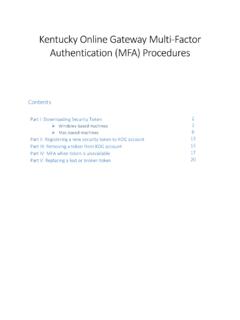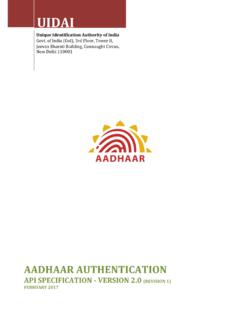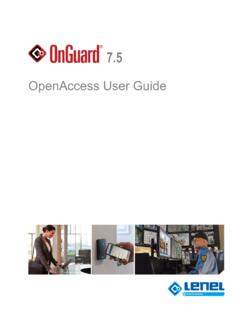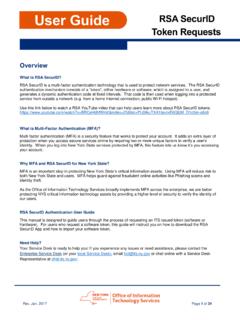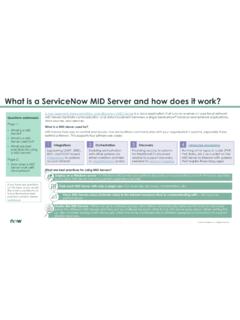Transcription of Digital Identity Guidelines - NIST
1 NIST Special Publication 800-63B Digital Identity Guidelines authentication and Lifecycle Management Paul A. Grassi James L. Fenton Elaine M. Newton Ray A. Perlner Andrew R. Regenscheid William E. Burr Justin P. Richer Privacy Authors: Naomi B. Lefkovitz Jamie M. Danker Usability Authors: Yee-Yin Choong Kristen K. Greene Mary F. Theofanos This publication is available free of charge from: NIST Special Publication 800-63B Digital Identity Guidelines authentication and Lifecycle Management Paul A. Grassi Elaine M. Newton Applied Cybersecurity Division Information Technology Laboratory Ray A. Perlner Andrew R. Regenscheid Computer Security Division Information Technology Laboratory James L. Fenton Altmode Networks Los Altos, Calif.
2 William E. Burr Dakota Consulting, Inc. Silver Spring, Md. Justin P. Richer Bespoke Engineering Billerica, Mass. Privacy Authors: Naomi B. Lefkovitz Applied Cybersecurity Division Information Technology Laboratory Usability Authors: Yee-Yin Choong Kristen K. Greene Information Access Division Information Technology Laboratory Jamie M. Danker National Protection and Programs Directorate Department of Homeland Security Mary F. Theofanos Office of Data and Informatics Material Measurement Laboratory This publication is available free of charge from: June 2017 INCLUDES UPDATES AS OF 03-02-2020; PAGE VIII Department of Commerce Wilbur L. Ross, Jr., Secretary National Institute of Standards and Technology Kent Rochford, Acting NIST Director and Under Secretary of Commerce for Standards and Technology Authority This publication has been developed by NIST in accordance with its statutory responsibilities under the Federal Information Security Modernization Act (FISMA) of 2014, 44 3551 et seq.
3 , Public Law ( ) 113-283. NIST is responsible for developing information security standards and Guidelines , including minimum requirements for federal systems, but such standards and Guidelines shall not apply to national security systems without the express approval of appropriate federal officials exercising policy authority over such systems. This guideline is consistent with the requirements of the Office of Management and Budget (OMB) Circular A-130. Nothing in this publication should be taken to contradict the standards and Guidelines made mandatory and binding on federal agencies by the Secretary of Commerce under statutory authority. Nor should these Guidelines be interpreted as altering or superseding the existing authorities of the Secretary of Commerce, Director of the OMB, or any other federal official.
4 This publication may be used by nongovernmental organizations on a voluntary basis and is not subject to copyright in the United States. Attribution would, however, be appreciated by NIST. National Institute of Standards and Technology Special Publication 800-63B Natl. Inst. Stand. Technol. Spec. Publ. 800-63B, 79 pages (June 2017) CODEN: NSPUE2 This publication is available free of charge from: Certain commercial entities, equipment, or materials may be identified in this document in order to describe an experimental procedure or concept adequately. Such identification is not intended to imply recommendation or endorsement by NIST, nor is it intended to imply that the entities, materials, or equipment are necessarily the best available for the purpose.
5 There may be references in this publication to other publications currently under development by NIST in accordance with its assigned statutory responsibilities. The information in this publication, including concepts and methodologies, may be used by federal agencies even before the completion of such companion publications. Thus, until each publication is completed, current requirements, Guidelines , and procedures, where they exist, remain operative. For planning and transition purposes, federal agencies may wish to closely follow the development of these new publications by NIST. Organizations are encouraged to review all draft publications during public comment periods and provide feedback to NIST.
6 Many NIST cybersecurity publications, other than the ones noted above, are available at Comments on this publication may be submitted to: National Institute of Standards and Technology Attn: Applied Cybersecurity Division, Information Technology Laboratory 100 Bureau Drive (Mail Stop 2000) Gaithersburg, MD 20899-2000 Email: All comments are subject to release under the Freedom of Information Act (FOIA). NIST SP 800-63B Digital Identity Guidelines : authentication & LIFECYCLE MANAGEMENT ii This publication is available free of charge from: Reports on Computer Systems Technology The Information Technology Laboratory (ITL) at the National Institute of Standards and Technology (NIST) promotes the economy and public welfare by providing technical leadership for the Nation s measurement and standards infrastructure.
7 ITL develops tests, test methods, reference data, proof of concept implementations, and technical analyses to advance the development and productive use of information technology. ITL s responsibilities include the development of management, administrative, technical, and physical standards and Guidelines for the cost-effective security and privacy of other than national security-related information in federal information systems. The Special Publication 800-series reports on ITL s research, Guidelines , and outreach efforts in information system security, and its collaborative activities with industry, government, and academic organizations. Abstract These Guidelines provide technical requirements for federal agencies implementing Digital Identity services and are not intended to constrain the development or use of standards outside of this purpose.
8 These Guidelines focus on the authentication of subjects interacting with government systems over open networks, establishing that a given claimant is a subscriber who has been previously authenticated. The result of the authentication process may be used locally by the system performing the authentication or may be asserted elsewhere in a federated Identity system . This document defines technical requirements for each of the three authenticator assurance levels. This publication supersedes corresponding sections of NIST Special Publication (SP) 800-63-2. Keywords authentication ; credential service provider; Digital authentication ; Digital credentials; electronic authentication ; electronic credentials, federation.
9 NIST SP 800-63B Digital Identity Guidelines : authentication & LIFECYCLE MANAGEMENT iii This publication is available free of charge from: Acknowledgments The authors gratefully acknowledge Kaitlin Boeckl for her artistic graphics contributions to all volumes in the SP 800-63 suite and the contributions of our many reviewers, including Joni Brennan from the Digital ID & authentication Council of Canada (DIACC), Kat Megas, Ellen Nadeau, and Ben Piccarreta from NIST, and Ryan Galluzzo and Danna Gabel O Rourke from Deloitte & Touche LLP. The authors would also like to acknowledge the thought leadership and innovation of the original authors: Donna F. Dodson, W. Timothy Polk, Sarbari Gupta, and Emad A. Nabbus. Without their tireless efforts, we would not have had the incredible baseline from which to evolve 800-63 to the document it is today.
10 In addition, special thanks to the Federal Privacy Council s Digital authentication Task Force for the contributions to the development of privacy requirements and considerations. Requirements Notation and Conventions The terms SHALL and SHALL NOT indicate requirements to be followed strictly in order to conform to the publication and from which no deviation is permitted. The terms SHOULD and SHOULD NOT indicate that among several possibilities one is recommended as particularly suitable, without mentioning or excluding others, or that a certain course of action is preferred but not necessarily required, or that (in the negative form) a certain possibility or course of action is discouraged but not prohibited. The terms MAY and NEED NOT indicate a course of action permissible within the limits of the publication.










